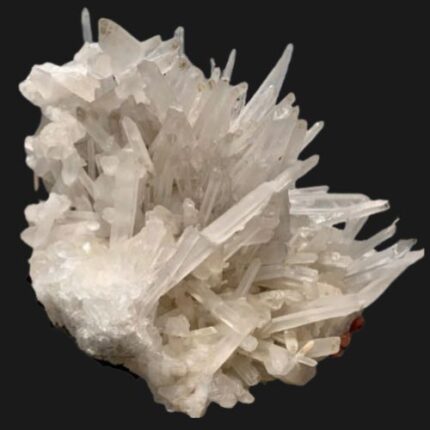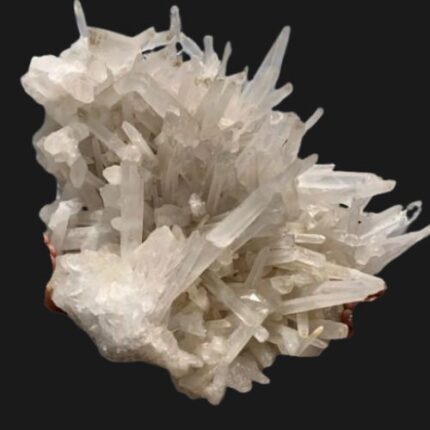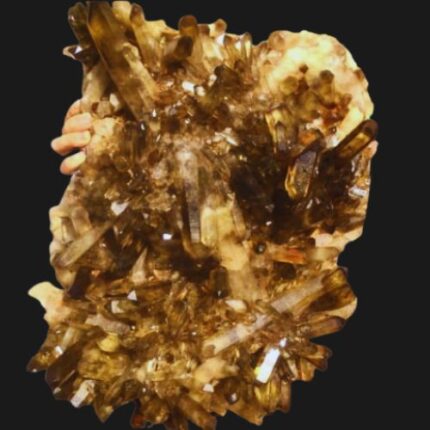15500 Grams Natural White Quartz Crystal Cluster Mineral Specimen
2380g Natural Citrine Cluster Quartz Crystal
Quartz gemstone is the hardest, captivating gemstone with a unique color variety. Moreover, explore uses in jewelry, spiritual significance and amazing color spectrum. Read also the price influence factors. Let's dive into the depth of quartz gemstone.
Definition of Quartz Gemstone
Quartz is a crystalline mineral that is a harder gemstone composed of silicon dioxide (silica). The atoms are closely packed in a continuous framework of SiO4 silicon–oxygen tetrahedra units are linked in a continuous framework with a variety of atoms. Moreover, the chemical formula of quartz gemstone is SiO2 in which each oxygen is shared with two tetrahedra. Moreover, the second most abundant mineral in Earth crust, behind feldspar is Quartz gemstone.
Quartz Varieties
Quartz have many different varieties, several of which are classified as gemstones and have more significance. Since it is one of the charming quartz antiquities, varieties with commonly used minerals in the making of jewelry and hardstone carvings, especially in Eurasia and Panama. However, unique Quartz Varieties include;
- Druzy Quartz which is a glittering layer of many tiny quartz crystals usually in a gray color.
- The other quartz was in Quartzite, a metamorphic rock made from at least 80 percent quartz, moreover, usually white, gray, and shades of red.
- Chert quartz is an opaque white, gray, tan, or pink sedimentary rock mostly composed of microcrystalline quartz.
- Flint quartz is a nearly opaque, dark-colored type of chert, colored by carbon-rich inclusions. Moreover, they may have brown, yellow, red, and white hues.
- Aventurine quartz is a mineral but actually a translucent quartz rock and has more significance.
Importance and Significance
The hardest gemstone, quartz, holds significant importance among all the crystals and gemstones. First and foremost, the most abundant gemstone with various colors like clear, rose, and smoky. Moreover, quartz is famous for its versatility, making it forever the best choice for both jewelry and spiritual practices. On the other hand, the metaphysical significance of quartz is famous for healing properties, promoting clarity and balance.
Additionally, many countries and cultures have had significant quartz for centuries, considering it a symbol of anatomy and energy. In short, the quartz gemstone stands out not only for its aesthetic appearance but also for its widespread availability and the positive vibes. Moreover, It always remains a gemstone that is thought to bring prosperity into people's lives.
Types of Quartz Gemstones
Here we discuss 15 types of Quartz gems are:
1. Rose Quartz Gemstone
Characteristics
Rose quartz gemstone is a rosy-red gemstone It usually has hazy translucence. Moreover, the color of the Rose quartz gemstone comes from small, fibrous, pink dumortierite inclusions and luster. In addition, Rose quartz gemstone in Pink color has more regular-shaped crystals, and its color will fade under UV-light, when falling on it.
Color Variations
The color variations in Rose quartz is a blush to rosy-red variety but may have purple or orange, red, purple, blue and green, and have occurred in rose quartz crystal lattice. Moreover, the pink variety of pink quartz is rare, which is due to phosphorus and aluminum, almost transparent and translucent.
Symbolic Meaning
Rose quartz gemstone is a symbol of femininity, love, compassion and sensitivity; use in crystal therapy treatments. Moreover, it promises to absorb the negative energy of the body and rebalance physical and mental well-being to use this gem.
Common Uses
Rose quartz gemstone is brilliant, capable of reflecting light and shining in the sun. Moreover, due to its undisputed elegance and beauty, rose quartz as a gem to create a rose quartz necklace, rings, bracelets, earrings and various jewels, common to wear.
2. Smoky Quartz
Appearance and Features
Smoky quartz is brown to gray black gemstone. Moreover, it is a translucent, yellow-brown to black quartz with an interior resembling floating smoke like. In addition, smoky color and haze occurs when natural irradiation enters in crystal defects (color centers) surrounding aluminum impurities.
3. Clear Quartz
Clarity and Transparency
Transparent or Clear quartz, pure quartz, or rock crystal all refer to the standard colorless, white. Rock or clear crystal is also a variety of very pure, colorless quartz and, usually, unlike milky quartz, perfectly transparent and therefore free of inclusions mostly. In addition, It is the most widespread quartz stone on earth, rock crystal has deposits that are widespread in nature.
4. Blue Quartz
Color Spectrum and characteristics:
In short, a translucent natural blue quartz has coloring from blue mineral inclusions mostly. Moreover, the blue quartz rare variety’s color is more subtle and less uniform than its synthetic nature.
Like tourmaline or dumortierite, there are multiple types of blue quartz, all colored by inclusions and variety. Furthermore, It’s called blue moon quartz, when it has a milky blue sheen from water or carbon dioxide inclusions.
5. White Quartz
Appearance and Coloration
With hazy translucence from water or carbon dioxide inclusions, Milky quartz is a white or pale gray variety that leans more toward opaque hue. Moreover, with gold inclusions, it's a gold quartz gemstone.
Common Deposits
White quartz, a famous gemstone, is commonly found in various geological regions. It occurs in granite, sandstone, and metamorphic rocks that have silica-rich fluids that crystallize over time. Moreover, deposits are often in diverse settings globally, making white quartz easily affordable.
Historical Uses
Throughout history, civilizations have more use of white quartz for both practical and symbolic purposes. In short, ancient cultures carved tools and weapons from this amazing gemstone due to its hardness. Additionally, white quartz held spiritual significance, associative to possess healing properties. Moreover, Its use in ancient rituals and cultures showcases its enduring role in human lifestyle.
Modern Applications
In contemporary times, white quartz continues to find applications in most industries. On the other hand, Its versatility makes it a sought-after material in construction for countertops and decorative purposes. Moreover, Its use in jewelry has also surged, with designers exploring its timeless and neutral appeal.
Moreover, the metaphysical properties associated to white quartz still resonate, contributing to its popularity in common practices. In short, from ancient tools to modern aesthetics, white quartz remains a significant gemstone with enduring appeal.
6. Black Quartz
Characteristics
Black quartz, known for its deep and dark look, is a variety of quartz crystal structure. Its color is due to the presence of minerals like tourmaline or other impurities. Moreover, the opaque nature of black quartz makes it from the more translucent forms of quartz.
Protective Properties
Black quartz gemstone has protective qualities and is thought to remove and change negative energy. Moreover, many countries use it as a grounding stone to enhance a sense of stability and security in their lives.
Aesthetic Uses
Black quartz is often used in jewelry and decorative purposes due to its striking appearance. Furthermore, It's dark allure increases a touch of mystery to rings, necklaces, and various artistic creations.
Cultural and Historical Significance
Black quartz has a more significant place in various cultures for its perceived protective energies. Moreover in modern times, it continues to be used for both its aesthetic and spiritual attributes.
7. Rutilated Quartz
Inclusions and Rutile Needles
Rutilated quartz is of needle-like inclusions of rutile, a mineral known for its golden or reddish-brown hue. However, these fine needles make unique patterns within the quartz structure.
Metaphysical Properties
Metaphysically, rutilated quartz is associated to enhance spiritual growth and creativity. Moreover, the rutile inclusions are thought to act as an energy booster, making this crystal popular among personality development.
Jewelry and Artistic Applications
Rutilated quartz in jewelry, showcasing the charming patterns created by the rutile needles. Moreover, Its artistic appeal extends beyond jewelry to sculptures and other decorations purposes, where the distinguished inclusions become focal points.
Rarity and Value
The rarity of well-formed rutile inclusions can touch the value of rutilated quartz. Furthermore, collectors and enthusiasts like the uniqueness of each piece, making it a sought-after gemstone collection.
8. Pink Quartz
Color Variations
Pink quartz is in its lovely color variations and is most popular in jewelry. Firstly, the color variations occurring in Pink quartz come in various shades, ranging from soft pastels to sharp pinks. Moreover, many people like pink quartz for its gentle and charming hues, making it a sought-after gemstone.
Popular in Jewelry
Now, shifting to its charming jewelry. Moreover, Jewelers often use pink quartz to make beautiful and elegant pieces. Rings, necklaces, and earrings with pink quartz are trendy choices for those who appreciate its delicate beauty.
9. Solar Quartz
Unique Patterns and Inclusions
Solar quartz stands out with amazing patterns and inclusions, and it holds spiritual significance. Furthermore, exploring its unique patterns and inclusions, solar quartz showcases captivating patterns that meet miniature landscapes.
These unique features make each piece of solar quartz jewelry truly one-of-a-kind.
Spiritual Significance
Solar quartz gives positive energy vibes and promotes harmony. Moreover, many of the individuals use solar quartz for spiritual power and spiritual practices due to its calming properties.
10. Rainbow Quartz
Multi-color Spectrum
Rainbow quartz is an astonishing gem with a multi-color spectrum. This unique rainbow quartz appears in a beautiful array of colors, resembling the hues of a rainbow. Moreover, this vibrant and lively display creates rainbow quartz, a favorite for those who love colorful and vibrant jewelry.
Geological Formation
Rainbow quartz forms when various minerals make layers, resulting in the charming colors.
The geological process behind rainbow quartz adds a pure layer of fascination for those interested in the Earth's natural process.
11. Yellow Quartz
Golden Hue
Yellow quartz, with its golden hue, exudes warmth and beauty. Firstly, the golden hue of yellow quartz emits a sunny and vibrant energy. It's like carrying a piece of sunshine radiation with you.
Positive Energy Properties
Secondly, yellow quartz is believed to have positive energy and charming properties. Many people think it brings happiness and uplifts spirits. Wearing it can boost your mood and emotional balance.
Popular Jewelry Choices
And speaking of wearing, it's no surprise that yellow quartz is mostly liked in the popular jewelry choices department. From earrings to pendants, it gives a touch of sunshine to your style.
12. Banded Quartz
Banding Patterns
Banded quartz rocks a charming look with its intriguing patterns. Let's dive into the mesmerizing world of its banding designs and where it comes from.
Firstly, the banding patterns in banded quartz make captivating stripes. Each layer represent a.geological story, making each piece one-of-a-kind.
Geological Origin
Secondly, banded quartz finds its geological origin in layers with different minerals. These layers, formed in a long time, contribute to the distinctive bands ever.
13. Purple Quartz
Shades of Purple
Purple quartz comes in a lot of shades, adding a touch of brilliance to your collection. Let's explore the different hues it offers.
Firstly, the shades of purple in this quartz, ranging from pale lavender to deep violet. The variety allows you to pick your favorite royal color quartz gemstone.
14. Star Quartz
Asterism Phenomenon
Star quartz gives charm with a stunning asterism phenomenon. Discover why it's rare and sought after. Firstly, the asterism phenomenon in star quartz makes a mesmerizing star-like pattern when light falls just right. It's similar to a galaxy in your hands.
Rarity and Collectability
Secondly, due to its indistinct beauty, star quartz is known for its rarity and collectability. People like t for its celestial charm and warm.
15. Cherry Quartz
Distinctive Color and Appearance
Cherry quartz is known for its distinctive color. Let's explore whether it's natural or synthesized and its uses in jewelry and beyond. Firstly, the distinctive color and look of cherry quartz resemble ripe cherries, making it eye-catching and sweet.
Manufactured or Natural
Secondly, some might wonder if it's manufactured or natural. The truth is, it's a man-made beauty, crafted to perfection.
Jewelry and Ornamental Uses
Thirdly, cherry quartz finds its place in jewelry and ornamental uses, adding a pop of color to accessories and decor.
Market Presence
Lastly, considering its vibrant appeal, cherry quartz has made its mark in the market presence. It's a popular choice for those who love bold and beautiful stones.
Crystal Structure and Formation
A. Quartz Crystal Structure
Quartz, a common crystal, has a charming structure. First, quartz crystals are arranged in a repeating unit pattern. These crystals have a six-sided structure, like a pyramid. Furthermore, the atoms inside quartz are closely packed, making a stable and orderly structure.
B. Geological Processes
Geological processes play an important role in crystal formation. Consider the following:
Over time, minerals in the Earth's crust cool and harden. Subsequently, pressure and heat deep within the Earth is associated with crystal growth. Moreover, volcanic activity and the movement of Earth's plates also affect the formation of crystals.
C. Environmental Factors
The environment that contributes to crystal formation is very important for quartz gemstone formation. Here's how:
External factors, such as temperature and pressure, affect crystal development. Additionally, the presence of specific minerals in the surroundings influences the nature of crystals formed. Furthermore, water can play a crucial role, dissolving minerals and helping in crystal growth.
Quartz Pricing Factors
When it comes to the cost of items, several factors affect the pricing.
Influencing Factors
To understand prices, consider these influencing factors:
Firstly, demand affects prices. If many people want something, its price may be high. Additionally, synthesis costs of quartz gemstone matter. Economic conditions, like inflation, also affect prices. When prices tend to rise and with decrease in money value.
Rarity and Availability
The rarity and availability of something affect its price:
Rare items are often more precious because they're not easy to find. If something is readily available, its price may be lower due to increase in supply.
Quality Grading
Quartz gemstone quality matters in pricing too.
Higher quality often means too much price. People are willing to pay more for good quality things. Grading systems help determine the price of items.
In short, prices effect due to the factors like demand, production costs, rarity, availability, and quality grading. Understanding these factors can give you insights into why certain things are too costly.
Conclusion
Quartz is a charming gemstone with various colors and uses. Overall, it's an amazing choice due to its affordability and versatility. In addition, quartz is used in jewelry and decorative items, making it approachable to many users. Moreover, its durability and low maintenance make it practical for everyday use jewelry. So, whether in clear, rose, or smoky forms, quartz continues to give luster in the world of gemstones.



